太湖地区水稻基肥自古以来就讲求肥力供应的“慢而长”以及“插下便兴旺”,《沈氏农书》[1]载:“肥气深入土中,徐徐讨力,且根派深远……垫底(基肥)多,插下便兴旺”。在我国水稻种植中,化学氮肥开始施用时,采用化肥与有机肥配施的方式,其结果表明,在有机肥的基础上增施化肥的处理水稻产量均显著增加[2]。如今,化学氮肥在肥料投入中的比例越来越大[3],化学氮肥的过量以及不合理施用,造成氮肥损失严重,已对土壤、大气和水体带来了一系列的负面影响,如近年来发现的大气雾霾与农业源氨排放密切相关,氮肥施用产生的氨排放的评估及其相关减排措施成为关注热点[4-6]。
稻田基蘖肥施用的氮肥一般超过全生育期氮肥用量的60%[7-9],目前水稻基肥大多采用表面撒施氮肥后再浅耕的施肥方式,分蘖肥则是在水稻移栽后10 d左右表面撒施,这样的施肥方式易导致稻田土-水表层存有大量的氨挥发底物NH4+-N,此时,水稻刚刚移栽,养分吸收能力较弱,在夏季高温环境下,易发生氨挥发损失。目前,田间直接测定氨排放的方法主要分为三类,分别为无干扰的微气象学法、强制换气的密闭室抽气法和静态的通气法。我国稻田氨挥发研究在20世纪80年代有个别采用了微气象学法[10-13],近年来的稻田氨排放研究大部分采用密闭室抽气法[14-16],少数研究采用通气法[17-18]。国际公认的监测农田氨排放的标准方法是微气象学法[19],该方法可监测施肥均匀的大面积农田向大气的实际氨排放量。就已经发表的稻田基蘖肥期氨排放结果而言,密闭室抽气法的结果普遍低于微气象学法(位于不同研究地点的非同步研究),其原因尚不明确。目前,我国稻田氨排放研究尚缺乏在同一田块上采用不同监测方法的同步对比研究,稻田基肥和分蘖肥施用后实际向大气排放氨的量仍不确定,这些现状将影响到稻田氨排放的科学评价以及稻田氮肥的合理施用,也影响到农业氨排放清单的制定及氨减排措施的实施。
本研究在太湖地区水稻基肥和分蘖肥施用后,同步采用微气象学法、密闭室抽气法和通气法对稻田氨排放通量的动态变化特征及主要影响因素进行了连续监测,以期对稻田氨排放的科学监测及氨排放量的评估提供支撑,为稻田氮肥的合理施用提供科学依据。
1 材料与方法 1.1 试验地概况试验在中国科学院常熟农业生态实验站(31º 15′15″N,120º57′43″E)开展。试验区年均气温15.5 ℃,年均降水量1 038 mm,年均无霜期224 d。土壤为湖积物发育而成的潜育型水稻土(乌栅土),表层(0~20 cm)土壤基本理化特征:pH(H2O)7.36,有机质35.0 g·kg-1,全氮2.09 g·kg-1,全磷0.93 g·kg-1,阳离子交换量(CEC) 20.2 cmol·kg-1。2017年水稻插秧至中期烤田期间气温见图 1。
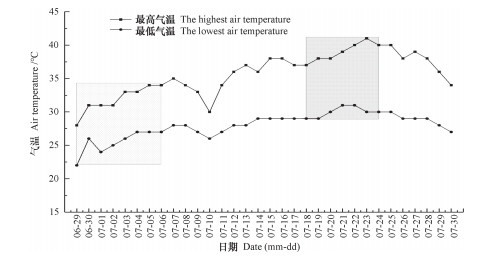
|
注:阴影部分表示基肥和分蘖肥施用后氨排放监测时间段Note: The shaded areas denote the periods of time ammonia emission was monitored after basal and tillering fertilization 图 1 水稻插秧至中期烤田期间的气温变化 Fig. 1 Dynamics of air temperature during the period between rice transplanting and midseason drainage |
试验开始前,以一块方形稻田中心处为圆心,规划出一个半径为20 m的圆形区域,在该区域内同步采用微气象学法、密闭室抽气法和通气法对稻田基肥和分蘖肥施用后的氨排放进行连续监测。微气象学法装置位于圆形区域中心处,密闭室抽气法和通气法监测装置各重复3次。圆形区域周围200 m无高大建筑物或树木,其周围稻田不施氮肥,在氨排放监测期间,试验区外围无明显氨排放源。
圆形区域内水稻全生育期施氮量270 kg·hm-2,氮肥品种为尿素,基肥施氮量为108 kg·hm-2,于2017年6月29日施用,施用方法为氮肥撒施后立即用铁搭将氮肥与表层土耙匀。水稻品种为南粳46,秧龄35 d,插秧密度为20 cm × 20 cm。分蘖肥于2017年7月18日施用,施用方法为表面撒施,施氮量为81 kg·hm-2。基肥和分蘖肥施用后氨排放监测期间保持3~5 cm的表面水层,7月29日至8月7日进行中期烤田。
1.3 氨排放监测方法 1.3.1 微气象学法微气象学法的质量平衡法(Integrated horizontal flux,IHF)的基本原理是气态氨的垂直通量等于不同高度氨的垂直截面上水平迁移总量[20],在任一高度上,氨的水平通量是该处的瞬时风速和氨浓度的乘积,迎风采样器可直接测定氨的水平通量,无需单独测定不同高度的风速和空气氨浓度[21]。基肥施用后,立即在圆心处竖杆上的五个高度(田面水上方0.4、0.8、1.2、1.8和2.8 m)分别放置内表面涂有草酸-丙酮溶液的迎风采样器[13]。在上风口非施氮区距离田面水表面1.2 m处放置迎风采样器,用于测定背景值,根据试验区风向标所示风向变化调整测定背景值的迎风采样器位置,保证其始终处于上风口处,避免受施肥区挥发氨的影响。迎风采样器每24小时更换一次,采回后用60 mL去离子水提取。迎风采样器气态氨的水平通量和IHF法氨排放通量的计算公式参见前文研究[22]。
1.3.2 密闭室抽气法密闭室抽气法装置由通气杆、抽气室、洗气瓶、流量计和真空泵等组成。抽气室顶部有2个通气孔,其中一个与通气杆相连,另一个与洗气瓶相连。通过真空泵产生的负压使抽气室内的气态氨被洗气瓶内的稀硫酸(0.01 mol·L-1)溶液吸收。监测期间抽气室内的换气次数为每分钟17次,抽气流量14.5 L·min-1。每天抽气时间段为上午8:00~9:00和下午4:00~5:00[22],以此时间段的氨挥发量作为日平均量算出日挥发量,直至施肥区氨排放量与非施肥区无明显差异为止。
1.3.3 通气法通气法装置采用内径15 cm、高度20 cm、两端开口的聚氯乙烯(PVC)圆筒,基肥施用后立即将圆筒一端插入土壤,在圆筒内上下两层分别放置一片半径15 cm、厚度2 cm的浸有15 mL磷酸甘油溶液的海绵,下层海绵用于吸收田面水表面挥发的氨; 上层海绵用于吸收外围空气中的氨[23]。下层海绵24 h更换一次,直至其氨挥发量与非施肥区无明显差异为止; 上层海绵48 h更换一次。将取回的下层海绵置于自封袋中,在实验室内向袋中加入300 mL的2 mol·L-1氯化钾溶液提取。
1.4 测定方法基肥与分蘖肥施用前3 d及施肥后8 d,于每天上午8:00在施肥区和非施肥区分别采集3个田面水样品,田面水NH4+-N浓度在当天测定。田面水pH在原位采用便携式pH计(SX-620,上海三信仪表厂)测定,所有水样的NH4+-N含量均采用靛酚蓝比色法测定。
1.5 数据分析监测数据采用Excel 2010进行处理,计算其平均值和标准偏差,作图软件采用Origin 9.0。
2 结果 2.1 基蘖肥施用后田面水NH4+-N浓度和pH动态变化在稻田翻地和泡田后,基肥施用前田面水NH4+-N浓度波动在1.0 ~ 3.0 mg·L-1之间,基肥施用后,施氮区田面水NH4+-N浓度迅速升高,在施肥后第3天达到峰值43.7 mg·L-1,之后逐渐下降,一周后与非施氮区无异; 分蘖肥施用后,施氮区田面水NH4+-N浓度在施肥后第2天达峰值47.4 mg·L-1(图 2)。在基肥和分蘖肥施用后,施氮区田面水pH开始升高,基肥施用后第3天和分蘖肥施用后第2天达8.3,一周后与无氮区接近(图 2)。
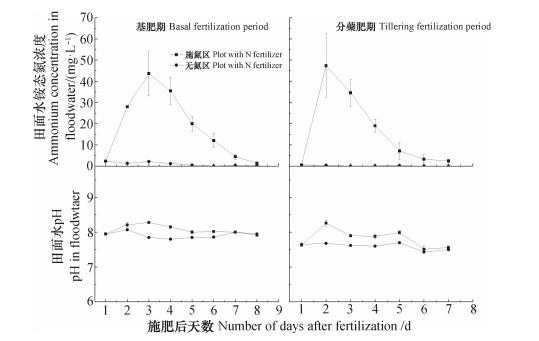
|
图 2 基肥和分蘖肥施用后田面水NH4+-N浓度和pH动态变化 Fig. 2 Dynamics of the ammonium concentration and pH in floodwater after application of the basal and tillering N fertilizer |
农田上方某一高度的氨水平通量是该处的氨浓度与瞬时风速的乘积,迎风采样器可直接监测氨的水平通量,不再需要一系列抽气装置和风速仪,大大减少了野外采样的劳动量。稻田基肥与分蘖肥施用后,田面水上方氨的水平通量迅速升高,且大致随田面水上方高度的降低而增加,对于本研究中的5个采样高度,在基肥施用后的5 d内,氨的水平通量在2.8 m处最小,在0.4 m处最大(图 3)。分蘖肥施用后的3 d内,氨的水平通量最大值则出现在0.8~1.2 m处。5个高度的氨水平通量除基肥施肥后第3天随高度的增加呈显著的指数形式降低外,其他时间段的水平通量不一定严格按照高度降低而逐步增加,这可能与气候因素如不同高度的气流特征有关。
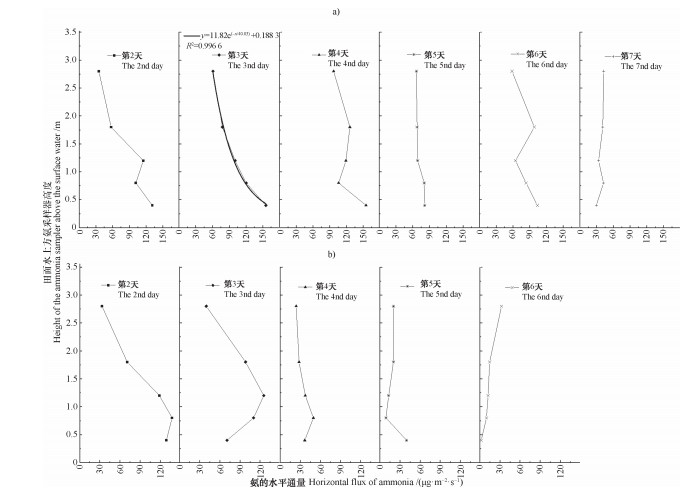
|
图 3 基肥a)分蘖肥b)施用后位于田面水上方5个高度的氨水平通量 Fig. 3 Horizontal ammonia flux after basal a) and tillering b) fertilization relative to height above the surface water |
采用三种方法监测的基肥和分蘖肥施用后稻田氨排放动态变化特征大体一致(图 4),氨排放峰值出现在基肥施肥后的第3~4天和分蘖肥施用后的第2天,基肥施肥7 d、分蘖肥施用5 d后不再有明显排放。微气象学法监测的基肥和分蘖肥施用后氨排放量峰值分别为8.8和12.5 kg·hm-2·d-1,密闭室抽气法监测的两次施肥后氨排放峰值分别为11.2和7.7 kg·hm-2·d-1,而通气法监测的氨排放量峰值仅为3.2和5.3 kg·hm-2·d-1。

|
图 4 基肥与分蘖肥施用后同步采用三种方法监测的氨排放动态变化 Fig. 4 Dynamics of ammonia emission after basal and tillering fertilization relative to three monitoring techniques |
尽管三种方法监测的氨排放量不同,但三种方法之间有良好的直线相关性(图 5)。在本研究中,微气象学法与密闭室抽气法之间的斜率为0.9,微气象学法与通气法之间的斜率为2.7,但不同种植系统中三者之间的关系尚不确定,需经过实地监测进一步研究。
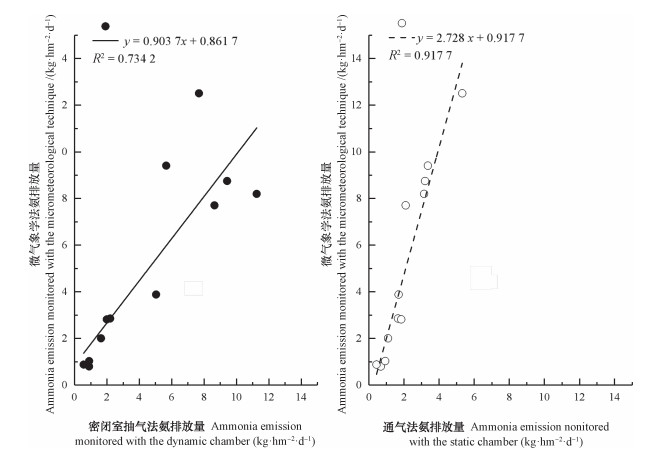
|
图 5 微气象学法与密闭室抽气法(左)以及通气法(右)监测的氨排放之间的相关性 Fig. 5 Relationships between ammonia emissions monitored with the micrometeorological technique and dynamic chamber technique (left), and static chamber technique (right) |
采用三种方法监测的水稻基肥和分蘖肥施用后同一天的氨排放量不同,但三种方法的日排放量均与田面水NH4+-N浓度呈显著线性相关(图 6),微气象学法、密闭室抽气法和通气法的决定系数R2分别为0.920 6、0.816 7和0.884 4,表明该试验地稻田基蘖肥期氨排放主要决定于田面水NH4+-N浓度。
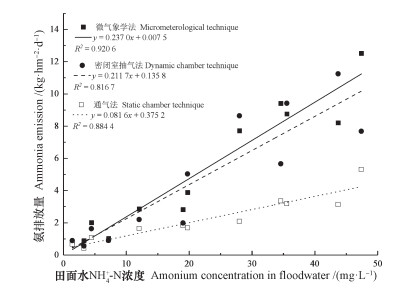
|
图 6 基肥和分蘖肥施用后三种方法监测的氨排放与田面水NH4+-N浓度之间的相关关系 Fig. 6 Relationship between ammonia emission and NH4+-N concentration in floodwater after basal and tillering fertilizer application relative to monitoring techniques |
基肥施用后,微气象学法、密闭室抽气法和通气法监测的稻田氨排放量分别为34.6、38.2和12.9 kg·hm-2,占基肥施氮量的32.0%、35.4%和11.9%;分蘖肥施用后,三种监测的氨排放量分别为26.7、16.8和11.8 kg·hm-2,占分蘖肥施氮量的33.0%、20.7%和14.6%(表 1)。
|
|
表 1 三种方法监测稻田基蘖肥施用后氨排放量及其占施氮量的比例 Table 1 Ammonia emission and its proportion of the amount of N fertilizer applied after basal and tillering fertilization relative to monitoring techniques |
综合基肥和分蘖肥期氨排放总量,密闭室抽气法和通气法分别是微气象学法的90%和40%。密闭室抽气法与微气象学法监测的氨排放结果比较接近,分别占施氮量的29.1%和32.4%,而通气法则低估了氨排放,仅占两次施肥施氮量的13.1%。
3 讨论 3.1 三种方法监测稻田基蘖肥期氨排放的差异稻田基肥和分蘖肥施用时水稻处于插秧及分蘖初期阶段,植株较小,施肥后土-水表面的氨排放基本等同于稻田生态系统的氨排放,不同方法监测氨排放通量的差异主要由挥发氨的收集方式引起。微气象学法属田间无干扰的收集方式,密闭室抽气法属压强制换气的收集方式,通气法则属于静态半密闭的被动收集方式。在本研究中,稻田基肥施用后,微气象学法氨排放量为34.6 kg·hm-2,密闭室抽气法为38.2 kg·hm-2,而通气法仅有12.9 kg·hm-2; 分蘖肥施用后,三种方法氨排放量分别为26.7、16.8和11.8 kg·hm-2,密闭室抽气法在基肥期稍高于微气象学法,而在分蘖肥期则低于微气象学法。综合两次施肥氨排放总量,微气象学法的结果与密闭室抽气法接近,通气法则严重低估了氨排放量,其原因主要是由于硬质圆筒内的空气交换受阻。
常规施氮量和施肥方式下,已有的密闭室抽气法测定稻田基肥期氨挥发研究的损失率为5%~33%[9, 24-26],分蘖肥期氨挥发损失率为13%~34%[7-8, 15, 24-25]。本研究采用密闭室抽气法测定基肥期和分蘖肥期氨排放损失率分别为35.4%和20.7%,高于大部分已发表的结果,这一方面与施肥后的气候条件有关,本研究中基肥与分蘖肥施用后一周均是晴热天气(图 1),有利于氨挥发的发生。造成密闭室抽气法监测结果差异大的重要影响因素还有换气次数,当换气次数在低于每分钟15次时,会低估氨排放[27],因此,建议在采用密闭室抽气法研究农田氨排放时,有必要详细说明抽气室规格、抽气流量以及抽气室内田面水-土壤表面距离气室顶部的高度。根据已开展的相关试验,当换气率超过每分钟17次时,测定的氨排放量可达到换气率为每分钟20次的95%,因此,推荐适宜的换气率为每分钟17~20次。另外一个因素易导致稻田基肥期氨排放的低估,即水稻种植之前的非淹水期间形成的土层与田埂之间的缝隙(水泥埂尤甚),在水稻基肥施用后试验小区内含有大量溶解态氮的田面水易进入缝隙而流失,从而造成氨挥发的低估,因此,试验小区四周宜采用压实的泥埂。
已有的研究[10-12, 28]采用微气象学法测定稻田基肥期氨挥发损失率范围为29%~40%,本研究中微气象学法测定的基肥期和分蘖肥期氨挥发损失率为32%和33%,与已有研究的结果一致。通气法结果普遍低于微气象学法,已有的研究[17-18]采用通气法测定稻田基肥期与分蘖肥期氨挥发损失率分别为8%~29%和6%~24.7%,本研究通气法测定基肥期与分蘖肥期氨排放损失率为11.9%和14.6%。
3.2 稻田全生育期氨排放及监测方法评述水稻氮肥一般分多次施用,稻田基肥和分蘖肥施用的氮肥一般占全生育期氮肥用量的60%左右,其余氮肥则在穗肥期施用。稻田基肥常规施肥方法是在泡田之后,在插秧之前撒施氮肥后进行浅耕,分蘖肥则是直接表面撒施,太湖地区单季晚稻基肥施用时间一般为6月中下旬,该段时间最高气温可达35℃,分蘖肥施用后最高温度则高达38~41℃,此时水稻处于插秧及活棵阶段,植株根系氮素吸收能力及地上部分捕获土-水表面挥发氨的能力均较弱,田面水中高浓度的NH4+-N在pH超过8的情况下,极易发生挥发损失至周围大气中。
微气象学法可监测农田生态系统冠层上方向大气的实际氨排放量。然而,由于该法需要的设备比较昂贵而且试验地面积较大,监测期间周围不能有明显氨排放源,因此,该方法适用于评价农田生态系统实际氨排放,但难以应用于多处理的对比试验。在本研究进行的2017年水稻季,采用微气象学法测定的水稻整个生育期氨排放为66.8 kg·hm-2,其中,基蘖肥期氨排放量为61.3 kg·hm-2,占整个水稻生育期氨排放的91.8%,基蘖肥期氨排放基本等同于整个水稻季的氨排放,这主要是由于在穗肥施用后,水稻冠层对土-水表面挥发氨的截获[29-30],导致即使穗肥采用表面撒施的方式,稻田生态系统向大气实际排放的氨量很低。
目前,绝大多数稻田氨排放研究所采用的密闭室抽气法,仅能在一天中的有限时间内监测土-水表面的氨排放,并以该时间段的排放量作为一天的平均值来估算全天的排放量,在水稻植株幼小时的基蘖肥期,该法监测的氨排放量与微气象学法接近。然而,该法会高估穗肥期的氨排放,密闭室抽气法测定的整个水稻生育期氨排放量为72.4 kg·hm-2,基蘖肥期氨排放占全生育期氨排放的76.0%。因此,密闭室抽气法可用于稻田基蘖肥期水稻植株幼小时的稻田氨排放监测,不适于水稻植株长大尤其是封行后的稻田氨排放监测。
通气法监测的是土-水表面的氨排放,无论是在基蘖肥期还是在穗肥期均低估了稻田氨排放量,该法仅适用于比较不同技术措施对氨排放的减排潜力,不适于评价稻田氨排放量。
稻田基蘖肥期所施氮肥的氨挥发损失严重,可通过氮肥深施[15, 18]、控释肥料[31]、添加脲酶抑制剂[16, 32]等举措减少氮肥的氨挥发损失,若能使稻田基肥“深入土中”,使土层与肥料合和为一,便可减少基肥施用后田面水中的NH4+-N,继而减少水稻活棵后分蘖肥的撒施量,实现稻田基蘖肥期的氨减排。
4 结论太湖地区单季晚稻在目前采用的常规施肥方式下,基肥和分蘖肥施用后氨挥发损失严重,采用无干扰的微气象学法监测的基肥和分蘖肥氨挥发分别占基肥和分蘖肥施氮量的32.0%和33.0%。密闭室抽气法监测两次施肥后氨挥发分别占施氮量的35.4%和20.7%。然而,通气法监测的基肥和分蘖肥氨挥发损失仅占施氮量的11.9%和14.6%。综合基蘖肥期两次施肥的氨排放总量,密闭室抽气法结果接近微气象学法,通气法由于其测定装置内换气受阻,导致采用该法监测的两次施肥氨排放总量仅是微气象学法的40.4%。三种方法监测的基蘖肥施用后氨排放动态变化特征大体一致,方法之间具有良好的相关性。考虑到采用微气象学法监测的稻田穗肥期水稻冠层上方氨排放并不严重,稻田氨减排对象应是基蘖肥施用后的氨排放。
| [1] |
张履祥辑补, 陈恒力校点.沈氏农书.北京: 中华书局, 1956 Zhang L X, Chen H L. Shen's book on agriculture(In Chinese). Beijing: Zhonghua Book Company, 1956 (  0) 0) |
| [2] |
曹隆恭. 我国稻作施肥发展史略. 中国农史, 1989(1): 83-89. Cao L G. Development history of rice fertilization in China (In Chinese). Agricultural History of China, 1989(1): 83-89. (  0) 0) |
| [3] |
颜晓元, 夏龙龙, 遆超普. 面向作物产量和环境双赢的氮肥施用策略. 中国科学院院刊, 2018, 33(2): 177-183. Yan X Y, Xia L L, Ti C P. Win-win nitrogen management practices for improving crop yield and environmental sustainability (In Chinese). Bulletin of Chinese Academy of Sciences, 2018, 33(2): 177-183. (  0) 0) |
| [4] |
巨晓棠, 谷保静, 蔡祖聪. 关于减少农业氨排放以缓解灰霾危害的建议. 科技导报, 2017, 35(13): 11-12. Ju X T, Gu B J, Cai Z C. Suggestions on reducing agricultural ammonia emissions to alleviate haze hazards (In Chinese). Science & Technology Review, 2017, 35(13): 11-12. (  0) 0) |
| [5] |
Aneja V P, Schlesinger W H, Erisman J W. Effects of agriculture upon the air quality and climate:research, policy, and regulations . Environmental Science & Technology, 2009, 43(12): 4234-4240.
(  0) 0) |
| [6] |
Zhang X M, Wu Y Y, Liu X J, et al. Ammonia emissions may be substantially underestimated in China . Environmental Science & Technology, 2017, 51(21): 12089-12096.
(  0) 0) |
| [7] |
田光明, 蔡祖聪, 曹金留, 等. 镇江丘陵区稻田化肥氮的氨挥发及其影响因素. 土壤学报, 2001, 38(3): 324-332. Tian G M, Cai Z C, Cao J L, et al. Ammonia volatilization from paddy field and its affecting factors in Zhenjiang hilly region (In Chinese). Acta Pedologica Sinica, 2001, 38(3): 324-332. DOI:10.3321/j.issn:0564-3929.2001.03.012 (  0) 0) |
| [8] |
周旋, 吴良欢, 戴锋, 等. 生化抑制剂组合与施肥模式对黄泥田稻季氨挥发的影响. 农业环境科学学报, 2018, 37(2): 399-408. Zhou X, Wu L H, Dai F, et al. Effects of combined biochemical inhibitors and fertilization models on ammonia volatilization in yellow clayey paddy field (In Chinese). Journal of Agro-Environment Science, 2018, 37(2): 399-408. (  0) 0) |
| [9] |
黄进宝, 范晓晖, 张绍林. 太湖地区铁渗水耕人为土稻季上氮肥的氨挥发. 土壤学报, 2006, 43(5): 786-792. Huang J B, Fan X H, Zhang S L. Ammonia volatilization from nitrogen fertilizer in the rice field of Fe-leachi-stagnic anthrosols in the Taihu Lake region (In Chinese). Acta Pedologica Sinica, 2006, 43(5): 786-792. DOI:10.3321/j.issn:0564-3929.2006.05.012 (  0) 0) |
| [10] |
Cai G X, Zhu Z L, Trevitt A, et al. Nitrogen loss from ammonium bicarbonate and urea fertilizers applied to flooded rice . Fertilizer Research, 1986, 10(3): 203-215. DOI:10.1007/BF01049350
(  0) 0) |
| [11] |
Zhu Z L, Cai G X, Simpson J, et al. Processes of nitrogen loss from fertilizers applied to flooded rice fields on a calcareous soil in north-central China . Fertilizer Research, 1988, 18(2): 101-115. DOI:10.1007/BF01049507
(  0) 0) |
| [12] |
Cai G X, Chen D L, Ding H, et al. Nitrogen losses from fertilizers applied to maize, wheat and rice in the North China Plain . Nutrient Cycling in Agroecosystems, 2002, 63(2/3): 187-195. DOI:10.1023/A:1021198724250
(  0) 0) |
| [13] |
Cai G X, Peng G H, Wang X, et al. Ammonia volatilization from urea applied to acid paddy soil in southern China and its control . Pedosphere, 1992, 2(4): 345-354.
(  0) 0) |
| [14] |
Li H, Chen Y, Liang X, et al. Mineral-nitrogen leaching and ammonia volatilization from a rice-rapeseed system as affected by 3, 4-dimethylpyrazole phosphate . Journal of Environmental Quality, 2009, 38(5): 2131-2137. DOI:10.2134/jeq2008.0476
(  0) 0) |
| [15] |
Yao Y L, Zhang M, Tian Y H, et al. Urea deep placement for minimizing NH3 loss in an intensive rice cropping system . Field Crops Research, 2018, 218: 254-266. DOI:10.1016/j.fcr.2017.03.013
(  0) 0) |
| [16] |
He T H, Liu D Y, Yuan J J, et al. A two years study on the combined effects of biochar and inhibitors on ammonia volatilization in an intensively managed rice field . Agriculture, Ecosystems & Environment, 2018, 264: 44-53.
(  0) 0) |
| [17] |
朱小红, 马中文, 马友华, 等. 施肥对巢湖流域稻季氨挥发损失的影响. 生态学报, 2012, 32(7): 2119-2126. Zhu X H, Ma Z W, Ma Y H, et al. Effect of fertilization on ammonia volatilization from paddy fields in Chao Lake Basin (In Chinese). Acta Ecologica Sinica, 2012, 32(7): 2119-2126. (  0) 0) |
| [18] |
Liu T Q, Fan D J, Zhang X X, et al. Deep placement of nitrogen fertilizers reduces ammonia volatilization and increases nitrogen utilization efficiency in no-tillage paddy fields in central China . Field Crops Research, 2015, 184: 80-90. DOI:10.1016/j.fcr.2015.09.011
(  0) 0) |
| [19] |
Sommer S G, Misselbrook T H. A review of ammonia emission measured using wind tunnels compared with micrometeorological techniques . Soil Use and Management, 2016, 32(S1): 101-108.
(  0) 0) |
| [20] |
Denmead O T, Simpson J R, Freney J R. A direct field measurement of ammonia emission after injection of anhydrous ammonia . Soil Science Society of America Journal, 1977, 41(5): 1001-1004. DOI:10.2136/sssaj1977.03615995004100050039x
(  0) 0) |
| [21] |
Leuning R, Freney J R, Denmead O T, et al. A sampler for measuring atmospheric ammonia flux . Atmospheric Environment, 1985, 19(7): 1117-1124. DOI:10.1016/0004-6981(85)90196-9
(  0) 0) |
| [22] |
田玉华, 曾科, 姚元林, 等. 基于不同监测方法的太湖地区水稻穗肥期氨排放研究. 土壤学报, 2019, 56(3): 693-702. Tian Y H, Zeng K, Yao Y L, et al. Ammonia emission following fertilization at booting stage of rice crop in Taihu Lake region relative to monitoring techniques (In Chinese). Acta Pedologica Sinica, 2019, 56(3): 693-702. (  0) 0) |
| [23] |
王朝辉, 刘学军, 巨晓棠. 田间土壤氨挥发的原位测定-通气法. 植物营养与肥料学报, 2002, 8(2): 205-209. Wang Z H, Liu X J, Ju X T. Field in situ determination of ammonia volatilization from soil:Venting method (In Chinese). Plant Nutrition and Fertilizer Science, 2002, 8(2): 205-209. DOI:10.3321/j.issn:1008-505X.2002.02.014 (  0) 0) |
| [24] |
Chen G, Chen Y, Zhao G H, et al. Do high nitrogen use efficiency rice cultivars reduce nitrogen losses from paddy fields? . Agriculture, Ecosystems & Environment, 2015, 209: 26-33.
(  0) 0) |
| [25] |
Wang J, Wang D J, Zhang G, et al. Effect of wheat straw application on ammonia volatilization from urea applied to a paddy field . Nutrient Cycling in Agroecosystems, 2012, 94(1): 73-84. DOI:10.1007/s10705-012-9527-8
(  0) 0) |
| [26] |
张静, 王德建. 太湖地区乌栅土稻田氨挥发损失的研究. 中国生态农业学报, 2007, 15(6): 84-87. Zhang J, Wang D J. Ammonia volatilization in gleyed paddy field soils of Taihu Lake region (In Chinese). Chinese Journal of Eco-Agriculture, 2007, 15(6): 84-87. (  0) 0) |
| [27] |
朱兆良, 蔡贵信, 徐银华, 等. 种稻下氮肥的氨挥发及其在氮素损失中的重要性的研究. 土壤学报, 1985, 22(4): 320-328. Zhu Z L, Cai G X, Xu Y H, et al. Ammonia volatilization and its significance to the losses of fertilizer nitrogen applied to paddy soil (In Chinese). Acta Pedologica Sinica, 1985, 22(4): 320-328. (  0) 0) |
| [28] |
宋勇生, 范晓晖, 林德喜, 等. 太湖地区稻田氨挥发及影响因素的研究. 土壤学报, 2004, 41(2): 265-269. Song Y S, Fan X H, Lin D X, et al. Ammonia volatilization from paddy fields in the Taihu Lake region and its influencing factors (In Chinese). Acta Pedologica Sinica, 2004, 41(2): 265-269. DOI:10.3321/j.issn:0564-3929.2004.02.016 (  0) 0) |
| [29] |
Hayashi K, Hiradate S, Ishikawa S, et al. Ammonia exchange between rice leaf blades and the atmosphere:Effect of broadcast urea and changes in xylem sap and leaf apoplastic ammonium concentrations . Soil Science and Plant Nutrition, 2008, 54(5): 807-818. DOI:10.1111/j.1747-0765.2008.00299.x
(  0) 0) |
| [30] |
Ashraf M, Mahmood T, Azam F. Translocation and recovery of 15N-labelled N derived from foliar uptake of 15NH3 by rice(Oryza sativa L.)cultivars . Biology and Fertility of Soils, 2003, 38(4): 257-260. DOI:10.1007/s00374-003-0649-7
(  0) 0) |
| [31] |
Wang X Z, Zhu J G, Gao R, et al. Nitrogen cycling and losses under rice-wheat rotations with coated urea and urea in the Taihu Lake region . Pedosphere, 2007, 17(1): 62-69. DOI:10.1016/S1002-0160(07)60008-3
(  0) 0) |
| [32] |
彭玉净, 田玉华, 尹斌. 添加脲酶抑制剂NBPT对麦秆还田稻田氨挥发的影响. 中国生态农业学报, 2012, 20(1): 19-23. Peng Y J, Tian Y H, Yin B. Effects of NBPT urease inhibitor on ammonia volatilization in paddy fields with wheat straw application (In Chinese). Chinese Journal of Eco-Agriculture, 2012, 20(1): 19-23. (  0) 0) |
 2019, Vol. 56
2019, Vol. 56

